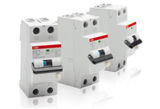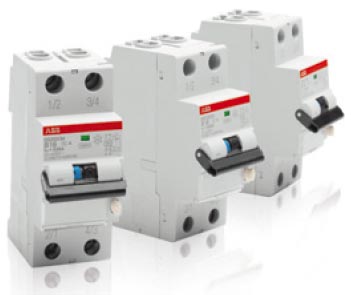Question from Voltimum user: "I have a bank of fluorescent lights on a circuit protected by a 20A RCBO and it keeps nuisance tripping. The circuit is only drawing about 8 Amps. I can find no earth leakage on the circuit also. Why does it trip? "

Answer provided by ABB technical expert Ian Richardson.
Most modern fluorescent light fittings have electronic ballasts fitted internally and these ballasts have a small leakage due to an internal high frequency filter required as part of their operation. Typical values of this leakage can be from 0.5 to 1mA per ballast. This leakage current can accumulate on a circuit and cause an RCBO to trip, even though the leakage may not be detected by a conventional earth leakage tester.
We should note that according to the product standard for RCBO’s, a 30mA device can possibly trip at any time above 15mA, so it may take as little as 15 ballasts to trip the circuit. The wiring standard AS/NZS3000 recommends that the accumulated leakage of a circuit should not exceed 30% of the sensitivity rating (10mA in the case of a 30mA rated device). The best way to avoid this nuisance tripping is to have less ballasts on each circuit by “circuit splitting” which will reduce the possibility of tripping due to accumulated leakage.
Occasionally the lighting ballasts may cause a trip due to the initial inrush during turning on a bank of lighting or on turn off of the bank of lighting due to the collapsing magnetic field affecting the operation of the RCBO. A reduction of the number of fittings on the circuit may also overcome this issue. On some occasions where the problem is severe a special high immunity RCBO may be necessary to overcome this problem as the high immunity device has specific characteristics against this type of nuisance tripping.
- See more at: http://www.voltimum.com.au/content/rcbo-keeps-nuisance-tripping#sthash.EBvh5YHj.dpufMost modern fluorescent light fittings have electronic ballasts fitted internally and these ballasts have a small leakage due to an internal high frequency filter required as part of their operation. Typical values of this leakage can be from 0.5 to 1mA per ballast. This leakage current can accumulate on a circuit and cause an RCBO to trip, even though the leakage may not be detected by a conventional earth leakage tester.
We should note that according to the product standard for RCBO’s, a 30mA device can possibly trip at any time above 15mA, so it may take as little as 15 ballasts to trip the circuit. The wiring standard AS/NZS3000 recommends that the accumulated leakage of a circuit should not exceed 30% of the sensitivity rating (10mA in the case of a 30mA rated device). The best way to avoid this nuisance tripping is to have less ballasts on each circuit by “circuit splitting” which will reduce the possibility of tripping due to accumulated leakage.
Occasionally the lighting ballasts may cause a trip due to the initial inrush during turning on a bank of lighting or on turn off of the bank of lighting due to the collapsing magnetic field affecting the operation of the RCBO. A reduction of the number of fittings on the circuit may also overcome this issue. On some occasions where the problem is severe a special high immunity RCBO may be necessary to overcome this problem as the high immunity device has specific characteristics against this type of nuisance tripping.
- See more at: http://www.voltimum.com.au/content/rcbo-keeps-nuisance-tripping#sthash.EBvh5YHj.dpufMost modern fluorescent light fittings have electronic ballasts fitted internally and these ballasts have a small leakage due to an internal high frequency filter required as part of their operation. Typical values of this leakage can be from 0.5 to 1mA per ballast. This leakage current can accumulate on a circuit and cause an RCBO to trip, even though the leakage may not be detected by a conventional earth leakage tester.
We should note that according to the product standard for RCBO’s, a 30mA device can possibly trip at any time above 15mA, so it may take as little as 15 ballasts to trip the circuit. The wiring standard AS/NZS3000 recommends that the accumulated leakage of a circuit should not exceed 30% of the sensitivity rating (10mA in the case of a 30mA rated device). The best way to avoid this nuisance tripping is to have less ballasts on each circuit by “circuit splitting” which will reduce the possibility of tripping due to accumulated leakage.
Occasionally the lighting ballasts may cause a trip due to the initial inrush during turning on a bank of lighting or on turn off of the bank of lighting due to the collapsing magnetic field affecting the operation of the RCBO. A reduction of the number of fittings on the circuit may also overcome this issue. On some occasions where the problem is severe a special high immunity RCBO may be necessary to overcome this problem as the high immunity device has specific characteristics against this type of nuisance tripping.
Have an ask the expert question? Try Voltimum's experts now!

